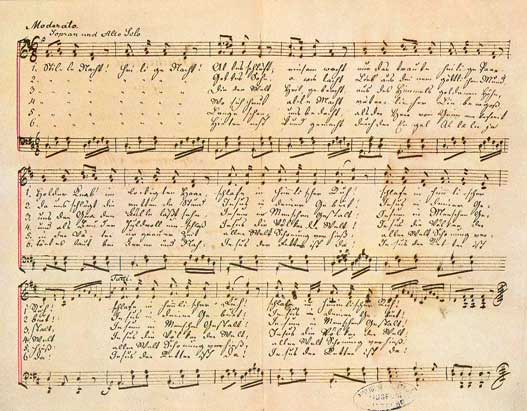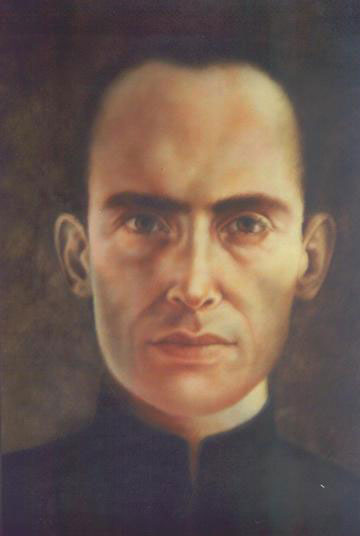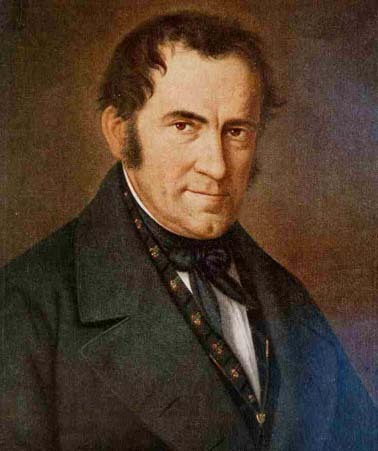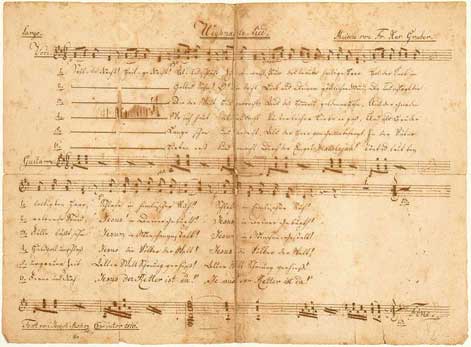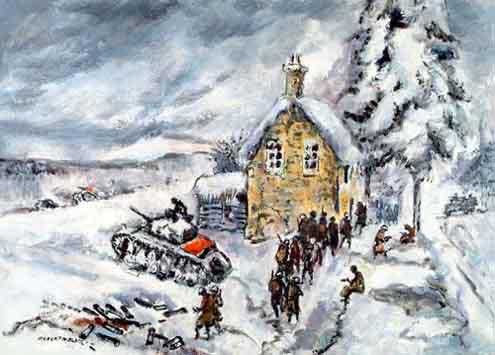Undated ‘Silent Night’ score by Joseph Mohr, estimated to have been written between 1820 and 1825; it was titled ‘Weynachts=Lied’ (‘Christmas Carol’)The Song Heard 'Round the World
‘Two souls, religiously and artistically gifted, coalesced in a new genius’
by Bill Egan
‘Mohr's Christmas joy flowed from heart and soul in captivating words; Gruber molded them into an exultant melody that immediately and ineluctably burst into song. That was their mutually shared moment of fortune. Two souls, religiously and artistically gifted, coalesced in a new genius, and created a masterpiece so seamless and perfectly homogeneous that many researchers ventured the opinion that only one person could have produced this masterpiece.’
The words for the Christmas carol we know as "Silent Night" were first set down on paper in 1816 in the tiny Alpine village of Mariapfarr, Austria. The fame of this composition spread throughout the world and 181 years later, people are still touched by both the simplicity and the strength of its message.
With music added by Franz Xaver Gruber in 1818, Joseph Mohr created a song so powerful it caused a World War I battle to temporarily cease as British and German soldiers sang of "heavenly peace" on Christmas Eve. During World War II, fighting was suspended on many fronts while people around the globe turned to their radios on Christmas Eve to hear opera star Ernestine Schumann-Heink sing "Stille Nacht." In addition to her status as an international opera star, Mme. Schumann-Heink was a mother with one son fighting for the Axis and another son fighting for the Allies. Her rendition of this inspired carol, first sung in the village of Oberndorf, Austria, had the power to bring a few moments of peace to a troubled world.
Today, in the U.S. we hear "Silent Night" played in shopping malls beginning in mid-October, yet "Stille Nacht! Heilige Nacht!" is more than just a Christmas song to the people of Austria. "It's considered a national treasure," reports Charlotte Mueller, an Ormond Beach, FL, resident born in Salzburg. "You won't hear it played on radio or television before Christmas Eve and it will never be used for advertising purposes. There is even an organization which was formed to protect it from commercialism."
The Stille Nacht Gesellschaft not only tries to protect the Mohr-Gruber composition, they try to encourage the use of the original melody, slightly different from the musical notes we learned in elementary school.
Frau Mueller says she has a special feeling for "Silent Night" because she knows people connected with various song-connected sites.
"The priest who oversees the parishes in Oberndorf and Arnsdorf, the historian in Arnsdorf, and the pastor of the pilgrimage church in Mariapfarr are very dear friends," she said. "My husband and I visited with each of them during a vacation in Austria last year."
A retired college professor, she attended school in Salzburg just a block from the Carolino Augusteum Museum where several "Stille Nacht" manuscripts are housed.
"Stille Nacht! Heilige Nacht!" was first performed in St. Nicholas Church, Oberndorf, Austria, at Christmas Midnight Mass in 1818, the result of a broken organ.
Various Disneyesque legends tell of mice nibbling at the organ bellows; however that nuisance was ongoing and could have been easily repaired. The real culprit was the nearby Salzach River, which flooded the area then, even as it does today. The dampness caused by periodic flooding caused rust and mildew in various workings of the organ, rendering it inoperable.
Father Joseph Mohr
Fr. Mohr, the curate at St. Nicholas, wanted music for the Christmas service. He walked to nearby Arnsdorf, where his friend Franz Xaver Gruber was schoolteacher and church organist, and asked for his help in creating a new song for Christmas. Since Fr. Mohr was also an excellent musician, it's possible that he may have already imagined part of the melody. He gave Gruber a poem he had written two years earlier, while a curate in Mariapfarr, and suggested that it could be set to music for a guitar accompaniment with two solo voices and chorus. At that time it was decided that the two men would sing the song with Mohr playing guitar and singing the melody and Gruber singing the bass part.
Returning to Oberndorf to prepare for the midnight service, he was greeted by Gruber several hours later with the completed song. Gruber also served as organist and choirmaster in Oberndorf. It would be an easy rehearsal for the choir, since they would merely repeat the last two phrases of each of the six verses in four-part harmony.
Franz Gruber
As the two men, backed by the choir, stood in front of the main altar in St. Nicholas Church and sang "Stille Nacht! Heilige Nacht!" for the first time, they could hardly imagine the impact their composition would have on the world. They were just trying to get through a difficult situation by providing music for Midnight Mass.
Karl Mauracher, a master organ builder and repairman from the Ziller Valley, traveled to Oberndorf to replace the organ; perhaps several years later. While doing his work in St. Nicholas, he obtained a copy of "Stille Nacht" and took it home with him. Thus, the simple carol, began its journey around the world as a "Tyrolean Folk Song."
Two traveling families of folk singers from the Ziller Valley, similar to the Trapp Family Singers, incorporated the song into their repertoire. According to the Leipziger Tageblatt, the Strassers sang the song in a concert in Leipzig in December 1832. During this period several musical notes were changed, and the carol evolved into the melody we know today. On another occasion, the Rainer Family sang the Christmas carol before an audience that included Emperor Franz I and Tsar Alexander I. In the year 1839, the Rainers performed "Stille Nacht" for the first time in America, at the Alexander Hamilton Monument outside Trinity Church in New York City.
Joseph Bletzacher, the Court Opera singer from Hannover, reported that by the 1840s the carol was already well known in Lower Saxony. "In Berlin," he said, "the Royal Cathedral Choir popularized it especially. It became in fact the favorite Christmas carol of the artistically appreciative King Frederick William IV of Prussia who used to have the Cathedral Choir sing it for him during the Christmas season each year."
A memorial plaque in Oberndorf, Austria, to Joseph Mohr and Franz Xaver Gruber, composers of ‘Silent Night! Holy Night!’
When the song had become famous throughout Europe, the author was dead and the composer was unknown. Although Franz Gruber wrote to music authorities in Berlin stating that he was the composer, the melody had been assumed to be the work of Haydn, Mozart or Beethoven at various times and these thoughts persisted even into the twentieth century. The controversy was put to rest two years ago when a long lost arrangement of "Stille Nacht" in the hand of Joseph Mohr was authenticated. In the upper right hand corner of the arrangement, Mohr wrote, "Melodie von Fr. Xav. Gruber."
The late Abbot Corbinian Hofmeister, O.S.B., of Metton Abbey, in Germany, provided an eloquent explanation for the universal appeal of "Silent Night": "Mohr's Christmas joy flowed from heart and soul in captivating words; Gruber molded them into an exultant melody that immediately and ineluctably burst into song. That was their mutually shared moment of fortune. Two souls, religiously and artistically gifted, coalesced in a new genius, and created a masterpiece so seamless and perfectly homogeneous that many researchers ventured the opinion that only one person could have produced this masterpiece."
‘The manuscript by Joseph Mohr is for guitar accompaniment and is probably the closest to the arrangement and melody sung at Midnight Mass in 1818.’During his lifetime, Franz Xaver Gruber produced a number of orchestral arrangements of his composition. The original guitar arrangement is missing, but five other Gruber manuscripts exist. The manuscript by Joseph Mohr (ca. 1820) is for guitar accompaniment and is probably the closest to the arrangement and melody sung at Midnight Mass in 1818.
Various Gruber and Mohr arrangements have been performed in concert in Volusia County for the past ten years. "Adventsingen" a holiday concert based on a 51-year old Salzburg program is performed by an interfaith chorus and soloists at Our Lady of Lourdes Church each December. The highlight of the annual Daytona Beach concert is the singing of what some have called the "world's most beautiful Christmas carol" following a special narration by WESH-TV news anchor Claire Metz. The narration varies from year to year because there are so many stories regarding the carol and its composers.
In Austria, interest in the song results in year 'round tourist business for many locations connected with "Silent Night" and its creators.
St. Nicholas Church in Oberndorf, where the song was first sung in 1818, was torn down in the early part of this century. The church foundations had been weakened by the flooding of the nearby Salzach River. In its place is the Silent Night Memorial Chapel and nearby one can visit the Silent Night Museum. The museum is housed in the former home of the church sacristan where Joseph Mohr rented a room while he was assigned to the Oberndorf parish.
A few miles away is the tiny hamlet of Arnsdorf, where Franz Gruber lived as schoolteacher and church organist. Frau Ottilie Aigner, the town historian gives tours through the still-operating school and one can see the recently restored Baroque pipe organ Guber played for Mass in Maria am Moesl Church adjacent to the school. Although Franz Gruber left Arnsdorf in 1839, not too much has changed. His desk remains in the same classroom and is still used by the current schoolteacher. On the second floor of the schoolhouse the rooms where Gruber lived and composed the melody for Mohr's Christmas carol can be visited. The centuries old church boasts one modern addition—an electronic carillon which plays the original "Stille Nacht" melody.
Later in his life, Gruber and his family moved to Hallein, now the site of the Franz Xaver Gruber Museum. It contains several furnished rooms in his former home along with outstanding exhibits dealing with the history of "Silent Night." His grave is outside the home and is decorated with a Christmas tree in December.
The pulpit Fr. Joseph Mohr preached from at his church in the Alpine town of Wagrain. He died penniless in Wagrain in 1848, having donated all his earnings to be used for the education of the children in the area.
Fr. Joseph Mohr's final resting place is in a tiny Alpine ski resort, Wagrain. He was born into poverty in Salzburg in 1792, and died penniless in Wagrain in 1848, where he had been assigned as pastor of the church. He had donated all his earnings to be used for the education of the children in the area. His memorial from the townspeople is the Joseph Mohr School located a dozen yards from his grave. The overseer of St. Johann's, in a report to the bishop, described Mohr as "a reliable friend of mankind; toward the poor, a gentle, helping father."
Many generations of the Mohr family lived in the Lungau region, in the southern part of the Province of Salzburg. The pilgrim church in Mariapfarr is within walking distance of the former home ofJoseph's grandfather. The climate is so invigorating and the Alpine air so clean, the town has become a major vacation destination for Europeans who want to get away from city life. A piece of land, once owned by one of Mohr's ancestors has been recently purchased and a Silent Night Museum is planned for the site. The pilgrim church where Mohr celebrated Mass is undergoing the restoration of its centuries-old frescos.
Joseph Mohr's birthplace at 9 Steingasse in Salzburg was opened as a museum just one year ago. German author, Hanno Schilf (The Story of Silent Night), who founded the museum reports that he had 12,000 visitors in the first year "without any advertising."
In a recent phone conversation, Schilf said the museum is so much more than what he had planned. "It's turning into a magical place," he said. "The people who visit have such a special regard for 'Silent Night', and the men who wrote it, that they seem to leave something of their spirit behind. Each time I walk in, I can feel the emotions of thousands of visitors who have been here."
Perhaps this is part of the miracle of "Silent Night." The words were written by a modest curate. The music was composed by a musician who was not known outside his village. There was no celebrity to sing the song at its world premiere. Yet its powerful message of heavenly peace has crossed all borders and language barriers, conquering the hearts of people everywhere.
Christmas historian Bill Egan, a retired Navy photojournalist and resident of Flagler Beach, Florida, is a staff writer for Year 'Round Christmas Magazine and provides Christmas research for Charles Osgood of "The Osgood File" on the CBS Radio Network. He is the producer of the annual "Adventsingen" concert in Daytona Beach and lectures on Christmas topics throughout the Eastern U.S. Bill has visited the various "Stille Nacht" locations to research the history of the world famous carol for the Austrian National Tourist Office [ANTO] and Austrian Information. Gabriele Wolf of ANTO Media Relations says that Bill Egan is the foremost "Silent Night" scholar in the U.S. and the Daytona Beach News-Journal cites him as one of the world's leading experts on the origins of the carol. This article was originally published in HalifaxMagazine, Daytona Beach, FL, Dec. 1997
Breakfast In the Snow: Battle of the Bulge by Robert N., Blair Center for Military History Collection‘Silent Night’ and A Moment of Peace
A World War II Story
Submitted by: WILLIAMSGK@aol.comOn 24 December 1944 I was spending my Christmas at a little place called Bastogne, Belgium, with the 101st Airborne Division. As many of you already know the story about the Battle of the Bulge, I won't go into all the details about how we were surrounded and outnumbered by the German Army. It was a cold, bitter, dark night and around about midnight surprisingly quiet.
All of a sudden, from the German position, we heard a single voice singing "Silent Night" in German. Soon more voices were added from the Germans. Suddenly, some American Soldier picked it up and before long most of us were singing along with the Germans. This went on for about five or 10 minutes and then stopped. A few minutes later we were back at each other, with guns blazing.
This incident has stayed in my memory all these years and when I hear "Silent Night" I remember. Later I talked to American, British and French Soldiers about it and some of them had experienced the same thing on whatever front they had been fighting on, (Italy, France, Holland). I have talked to Veterans of WWI and they tell similar stories.
In the middle of the worst battle of WW2 there was Peace on Earth for a few minutes.
‘Silent Night,’ Enya (Irish lyrics)
Founder/Publisher/Editor: David McGee
Contributing Editors: Billy Altman, Laura Fissinger, Christopher Hill, Derk Richardson
Logo Design: John Mendelsohn (www.johnmendelsohn.com)
Website Design: Kieran McGee (www.kieranmcgee.com)
Staff Photographers: Audrey Harrod (Louisville, KY; www.flickr.com/audreyharrod), Alicia Zappier (New York)
E-mail: thebluegrassspecial@gmail.com
Mailing Address: David McGee, 201 W. 85 St.—5B, New York, NY 10024


